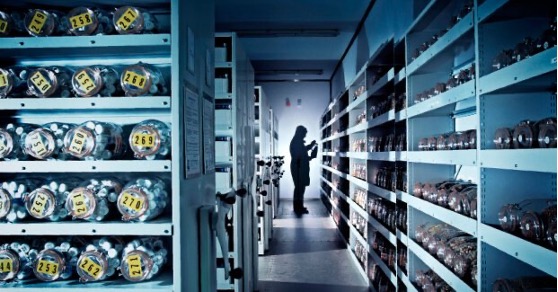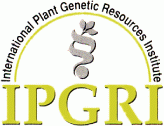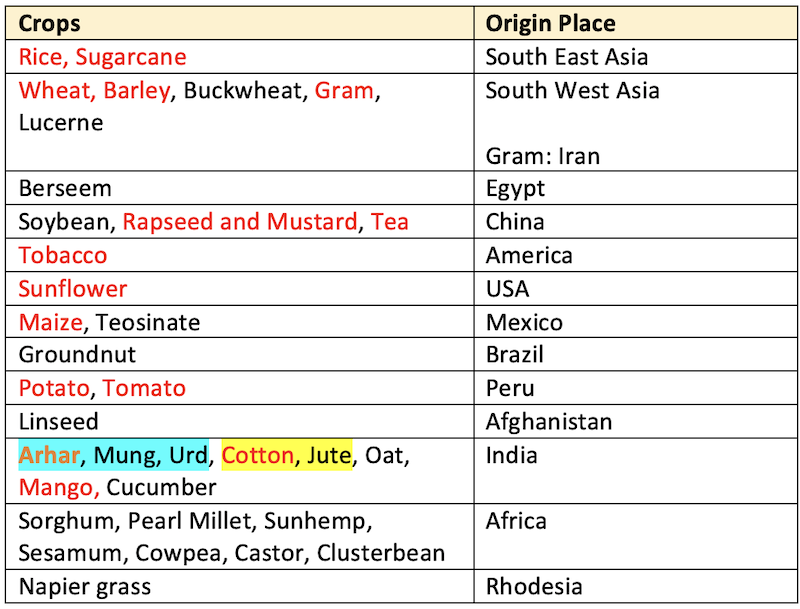🎹 Germplasm
Features, Kinds, Classification of Gene Pool
Plant Genetic Resources
- The sum total of genes in a crop species is referred to as genetic resources. or
- Gene pool refers to a whole library of different alleles of a species or
- Germplasm may be defined as the sum total of hereditary material i.e., all the alleles of various genes present in a crop species and its wild relatives.
- Also known as gene pool or genetic stock or germplasm or genetic resources.
- Germplasm or gene pool is the basic material with which a plant breeder has to initiate his breeding programme.
Features
- Gene pool represents the entire genetic variability or diversity available in a crop species.
- Germplasm consists of land races, modern cultivars, obsolete cultivars, breeding stocks, wild forms and wild species of cultivated crops.
- Germplasm includes both cultivated and wild species and relatives of crop plants.
- Germplasm is collected from the centres of diversity, gene banks, gene sanctuaries, farmers’ fields, markets and seed companies.
- Germplasm is the basic material for launching a crop improvement programme.
- Germplasm may be indigenous (collected within country) or exotic (collected from foreign countries).
Kinds of Germplasm
👉🏻 The germplasm consists of various plant materials of a crop such as
- Land races
- Obsolete cultivars
- Modern cultivars
- Advanced (homozygous) Breeding materials
- Wild forms of cultivated species
- Wild relatives
- Mutants
👉🏻 These are briefly discussed below:
1. Land races
- These are nothing but primitive cultivars which were selected and cultivated by the farmers for many generations without systematic plant breeding efforts.
- Land races were not deliberately bred like modern cultivars. They evolved under subsistence agriculture.
- Land races have high level of genetic diversity which provides them high degree of resistance to biotic and abiotic stresses.
- Land races have broad genetic base which again provides them wider adaptability.
- The main drawbacks of land races are that they are less uniform and low yielders.
- Land races were first collected and studied by N.I. Vavilor in rice.
2. Obsolete Cultivars
- These are the varieties developed by systematic breeding effort which were popular earlier and now have been replaced by new varieties.
- Improved varieties of recent past are known as obsolete cultivars.
- Obsolete varieties have several desirable characters they constitute an important part of gene pool. Example: Wheat varieties K65, K68, PB 591 were most popular traditional tall varieties before introduction of high yielding dwarf Mexican wheat varieties. Now these varieties are no more cultivated. They are good genetic resources and have been widely used in wheat breeding programmes for improvement of grain quality. Now such old varieties are found in the gene pool only.
3. Modern cultivars
- The currently cultivated high yielding varieties are referred to as modern cultivars. They are also known as improved cultivars or advanced cultivars.
- These varieties have high yield potential and uniformity as compared to obsolete varieties land races.
- They constitute a major part of working collections and are extensively used as parents in the breeding programmes.
- As these are good sources of genes for yield and quality, can be introduced in a new area and directly released.
- However, these have narrow genetic base and low adaptability as compared to land races
4. Advanced breeding lines
- These are pre-released plants which have been developed by plant breeders in modern scientific breeding programmes. These are known as advanced lines, cultures and stocks.
- This group includes, nearly homozygous lines, lines derived from biotechnology programmes i.e. transgenic plants and mutant lines etc.
- These lines which are not yet ready for release to farmers. They often contain valuable gene combinations.
5. Wild forms of cultivated species
- Wild forms of cultivated species are available in many crop plants.
- Such plants have generally high degree of resistance to biotic and abiotic stresses and are utilized in breeding programmes.
- They can easily cross with cultivated species.
- Wild forms of many crop species are extinct.
6. Wild Relatives
- Those naturally occurring plant species which have common ancestry with crops and can cross with crop species are referred to as wild relatives or wild species.
- Wild relatives include all other species, which are related to the crop species by descent during their evolution. Both these groups are sources of valuable genes for biotic and abiotic stress and for quality traits and yield.
7. Mutants
- Mutation breeding is used when the desired character is not found in the genetic stocks of cultivated species and their wild relatives.
- Mutations do occur in nature as well as can be induced through the use of physical and chemical mutagens.
- The extra variability which is created through induced mutations constitutes important components of gene pool. Mutant for various characters sometimes may not be released as a variety, but they are added in the gene pool.
- The germplasm includes those carrying gene mutations, chromosomal aberrations and markers genes etc. are considered special genetic stocks. They are useful in breeding programmes.
Classification of Gene Pool
- The pool of a crop includes all cultivars, wild species and wild relatives containing all the genes available for breeding use.
- Based on degree of relationship, the gene pool of crops can be divided into three groups (Harland and Dewet, 1971), viz.,
- Primary Gene Pool
- Secondary Gene Pool
- Tertiary Gene Pool
- These are briefly discussed below:
1. Primary gene pool (GP1)
- This is also known as gene pool one (GP1).
- The gene pool in which intermating is easy and leads to production of fertile hybrids is known as primary gene pool.
- It includes plants of the same species or of closely related species which produce completely fertile offspring on intermating.
- In such gene pool, genes can be exchanged between lines simply by making normal crosses.
- This is the material of prime breeding importance.
2. Secondary gene pool (GP2)
- This type of gene pool is also known as gene pool two (GP2).
- The genetic material that leads to partial fertility on crossing with GP1 is referred to as secondary gene pool. It includes plants that belong to related species.
- Such material can be crossed with primary gene pool, but usually the hybrids are sterile and some of the progeny to some extent are fertile.
- Transfer of gene from such material to primary gene pool is possible but difficult.
3. Tertiary gene pool (GP3)
- The genetic material which leads to production of
sterile hybridson crossing with primary gene pool is termed as tertiary gene pool or gene pool three (GP3). - It includes material which can be crossed with GP1, but the hybrids are sterile.
- Transfer of genes from such material to primary gene pool is possible with the help of special techniques.
Germplasm activities
👉🏻 There are six important activities related to plant genetic resources.
- Exploration and Collection
- Conservation
- Evaluation
- Documentation
- Multiplication and Distribution
- Utilization
1. Exploration
- Exploration refers to collection trips and collection refer to tapping of genetic diversity from various sources and assembling the same at one place. The exploration and collection is a highly scientific process. This process takes into account six important items, viz,
- sources of collection
- priority of collection
- agencies of collection
- methods of collection
- methods of sampling
- sample size.
✅ Merits
- Collection helps in tapping crop genetic diversity and assembling the same at one place.
- It reduces the loss of genetic diversity due to genetic erosion.
- Sometimes, we get material of special interest during exploration trips.
- Collection also helps in saving certain genotypes from extinction.
❌ Demerits
- Collection of germplasm especially from other countries, sometimes leads to entry of new diseases, new insects and new weeds.
- Collection is a tedious job.
- Collector, sometimes has encounter with wild animals like elephants, tigers etc.
- Transportation of huge collections also poses difficulties in the exploration and collection.
Germplasm Conservation
- Conservation refers to protection of genetic diversity of crop plants from genetic erosion. or
- Germplasm conservation refers to maintain the collected germplasm in such a state that there is minimum risk for its loss and that either it can be planted directly in the field or it can be prepare for planting with relative ease whenever necessary.
- There are two important methods of germplasm conservation or preservation viz.,
- In situ conservation
- Ex situ conservation
1. In situ conservation
- Conservation of germplasm
under natural habitatis referred to as in situ conservation. - This is achieved by protecting this area from human interference. Such an area is often called as
natural park,biosphere reserveorgene sanctuary.
Gene Sanctuaries
- The genetic diversity is sometimes conserved under natural habitat. The areas of great genetic diversity are protected from human interference. These protected areas in natural habitat are referred to as gene sanctuaries.
- Gene sanctuary is also Known As Natural Park or Biosphere Reserve.
- A gene sanctuary is best located within the centre of origin of crop species concerned, preferably covering the microcenter with in the centre of origin.
- India has setup its first gene sanctuary in the Garo Hills of Assam for wild relatives of citrus. Efforts are also being made to setup gene sanctuaries for Banana, Sugarcane, Rice and Mango.

- In Ethiopia gene sanctuary for conservation of wild relatives of Coffee was setup in 1984.
NBPGR, New Delhiis making attempts to establish gene sanctuaries in Meghalaya for Citrus and in the North-Eastern region for Musa, Citrus, Oryza, Saccharum and Mengifera genus.
✅ Merits
- A gene sanctuary not only conserves the existing genetic diversity present in the population, it also allows evolution to continue. As a result, new alleles and new gene combinations would appear with time.
- The risks associated with ex situ conservation are not operative.
❌ Disadvantages
- Each protected area will cover only very small portion of total diversity of a crop species, hence several areas will have to be conserved for a single species.
- The management of such areas also poses several problems.
- This is a costly method of germplasm conservation
Ex situ conservation
- Conservation of germplasm
away from its natural habitatis called ex situ germplasm conservation.
✅ Merits
- It is possible to preserve entire genetic diversity of a crop species at one place.
- Handling of germplasm is also easy.
- This is a cheap method of germplasm conservation
👉🏻 Seed Collection
- Preservation in the form of seed is the most common and easy method, relatively safe, requires minimum space and easy to maintain.
- Glass, tin or plastic containers are used for preservation and storage of seeds. The seed can be conserved under long term, medium term and short-term storage conditions.

- Roberts in 1973 classified seeds on the basis of their storability, into two major groups. viz.,
- Orthodox Seeds: Seeds of this type
can be dried to low moisture content of 5%and stored at a low temperature without losing their viability are known as orthodox seeds. Most crop seeds belong to this category. Such seeds can be easily stored for long periods; their longevity increases in response to lower humidity and storage temperature. Eg. Wheat, Rice, Corn, Chickpea, Cotton, Sunflower etc. - Recalcitrant Seeds: The viability of this group of seeds drops drastically if their moisture content is reduced below 12-30%. Seeds of many forest and fruit trees, and of several tropically crops like Citrus, mango, coffee, cocoa, rubber, oil palm, jackfruit, etc. belong to this group. Such seeds present considerable difficulties in storage. They require in situ conservation.
3. Evaluation
- Evaluation refers to screening of germplasm in respect of morphological, genetical, economic, biochemical, physiological, pathological and entomological attributes.
- Evaluation requires a team of specialists from the disciplines of plant breeding, physiology, biochemistry, pathology and entomology.
- First of all a list of descriptors (characters) for which evaluation has to be done is prepared. This task is completed by a team of experts from
IPGRI, Rome, Italy. - The descriptors are ready for various crops.
- The evaluation of germplasm is down in three different places, viz., (1) in the field, (2) in green house, and (3) in the laboratory.
4. Documentation
- It refers to compilation, analysis, classification storage and dissemination of information.
- In plant genetic resources, documentation means dissemination of information about various activities such as collection, evaluation, conservation, storage and retrieval of data.
- Now the term documentation is more appropriately known as information system. Documentation is one of the important activities of genetic resources.
- Large number of accessions are available in maize, rice, wheat, sorghum, potato and other major crops.
- About 7.3 million germplasm accessions are available in 200 crops species. Handling of such huge germplasm information is only possible through electronic computers.
5. Distribution
- The specific germplasm lines are supplied to the users on demand for utilization in the crop improvement programmes.
- Distribution of germplasm is the responsibility of the gene bank centres.
- The germplasm is usually supplied to the workers who are engaged in research work of a particular crop species.
- Supplied free of cost to avoid cumbersome work of book keeping.
- The quantity of seed samples depends on the availability of seed material and demands
- Proper records are maintained about the distribution of material.
- It helps in acclimatization and purification of the material.
6. Utilization
- It refers to use of germplasm in crop improvement programmes. The germplasm can be utilized in various ways.
- The uses of cultivated and wild species of germplasm are briefly discussed below:
- Cultivated Germplasm
- It can be used in three main ways: (1) as a variety, (2) as a parent in the hybridization, and (3) as a variant in the gene pool.
- Wild Germplasm
- It is used to transfer resistance to biotic and abiotic stresses, wider adaptability and sometimes quality such as fibre strength in cotton.
Organizations associated with germplasm
- International Plant Genetic Resources Institute, (IPGRI)
Rome, Italy

- National Bureau of Plant Genetic Resources, (NBPGR)
New Delhi

Genetic Erosion
- Genetic erosion refers to loss of genetic diversity between and within populations of the same species over a period of time. or
- Gradual reduction in genetic diversity in the populations of a species, due to elimination of various genotypes, is called genetic erosion.
- Thus, genetic erosion leads to reduction of the genetic base of a species due to human intervention and environmental changes.
- There are five main reasons of genetic erosion:
- Replacement of land races with improved cultivars: The main features of modern cultivars are high yield, uniformity, narrow genetic base and narrow adaptability. On the other hand land races and primitive cultivars have more genetic diversity, broad genetic base, wider adaptability and low yield potential. Thus replacement of land races with modern cultivars has resulted in reduction in genetic diversity because land races are disappearing.
- Modernization of agriculture: Clean and modern agriculture, Improved crop management practices has resulted in the elimination of wild and weedy forms of many crops. These weedy forms enhance the genetic diversity through introgression of genes from crop to weedy forms and weedy forms to crop plants.
- Extension of farming into wild habitats: It has resulted in destruction of wild relatives of various crops resulting in reduction of their genetic diversity.
- Grazing into wild habitats: Grazing of animals in the wild habitat also reduces genetic diversity by destroying the wild and weedy forms of crop plants.
- Developmental activities like Hydroelectric projects, growth of towns, cities, roads, air ports and industrial areas also lead to genetic erosion of crop plants, because vast areas are cleaned for such activities.
Extinction
- Extinction refers to permanent loss of a crop species due to various reasons.
Introgression
- Transfer of few genes from one species into the full diploid chromosome complement of another species.
Gene banks
- Gene bank refers to a place or organization where germplasm can be conserved in living state.
- Gene banks are also known as germplasm banks.
- The germplasm is stored in the form of seeds, pollen or in vitro cultures, or in the case of a field gene banks, as plants growing in the field.
- Types:
- Seed gene banks
- Plant or field gene banks
- Meristem gene banks
- Cell and organ gene banks and
- DNA gene banks
Centre of Origin
- A center of origin (or center of diversity) is a geographical area where a group of organisms, either domesticated or wild, first developed its distinctive properties.
- They are also considered
centers of diversity. - Centers of origin were first identified in 1924 by
N. Vavilov. - Vavilov centers are regions where a high diversity of crop wild relatives can be found, representing the natural relatives of domesticated crop plants. Later in 1935 Vavilov divided the centers into
12, giving the following list:- Chinese center
- Indian center
- Indo-Malayan center
- Central Asiatic center
- Persian center
- Mediterranean center
- Abyssinian center
- North American center
- South American center
- Central American center
- Chilean center
- Brazilian-Paraguayan center
Origin Places of Important Crops

Law of homologous series
- The concept of parallel variation also known as law of homologous series of variation was developed by
Vavilov (1951)based on his study of crop diversity and centres of origin. - Law of homologous series states that a particular variation observed in a crop species is also expected to be available in its related species.
- For instance, if we get dwarf collections in one species of a crop, the same may be observed in another related species also.
- Vavilov used principle of homologous series of variation as a clue for discovering similar characters in related species.
Plant Genetic Resources
- The sum total of genes in a crop species is referred to as genetic resources. or
- Gene pool refers to a whole library of different alleles of a species or
- Germplasm may be defined as the sum total of hereditary material i.e., all the alleles of various genes present in a crop species and its wild relatives.
- Also known as gene pool or genetic stock or germplasm or genetic resources.
- Germplasm or gene pool is the basic material with which a plant breeder has to initiate his breeding programme.
Features
- Gene pool represents the entire genetic variability or diversity available in a crop species.
- Germplasm consists of land races, modern cultivars, obsolete cultivars, breeding stocks, wild forms and wild species of cultivated crops.
- Germplasm includes both cultivated …
Become Successful With AgriDots
Learn the essential skills for getting a seat in the Exam with
🦄 You are a pro member!
Only use this page if purchasing a gift or enterprise account
Plan
Rs
- Unlimited access to PRO courses
- Quizzes with hand-picked meme prizes
- Invite to private Discord chat
- Free Sticker emailed
Lifetime
Rs
1,499
once
- All PRO-tier benefits
- Single payment, lifetime access
- 4,200 bonus xp points
- Next Level
T-shirt shipped worldwide

Yo! You just found a 20% discount using 👉 EASTEREGG

High-quality fitted cotton shirt produced by Next Level Apparel